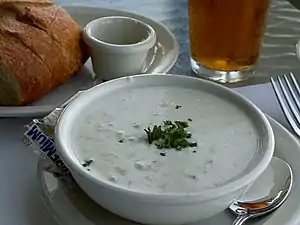Bulkie roll
A bulkie roll or bulkie is a New England regional variety of sandwich roll. Sandwiches made with bulkie rolls are common in area delicatessens, restaurants, and institutional food services. Bulkie rolls are larger and firmer than hamburger buns. The crust is usually slightly crisp or crunchy, but bulkie rolls are not hard rolls. The bread within the roll is similar to ordinary white bread, with a texture that is neither very chewy nor very fluffy, without any yellow color or egg taste, and not noticeably sweet. They are either plain or topped with poppy seeds.
 Spicy salmon burger on a bulkie | |
| Alternative names | Bulkie |
|---|---|
| Type | Bread roll |
| Place of origin | |
| Region or state | |
They are similar to and sometimes equated with kaiser rolls, but kaiser rolls are noticeably sweeter and often topped with poppy seeds.[1]
History
Lee Shai Weissbach writes of a Manchester, New Hampshire, Jewish grocery store, pre-World-War-II, whose owner was "affectionately remembered for 'the barrel of pickles and the hefty corned-beef sandwiches on bulkie rolls that he dispensed.'"[2]
Etymology
"Bulke" or "Bilke" (בולקע/בילקע; translit. bʊlkɛ/bɪlkɛ) is the Yiddish language word for a small roll made with fine wheat flour and kneaded with eggs.[3] It may be derived from a Polish word for roll ("bułka"); prior to the Holocaust, a very large Jewish community lived in Poland[4] and the Yiddish language takes approximately 15% of its vocabulary from Slavic languages, including Polish.[5]
References
- Emily Chasan, 2004, Tufts University: Off the Record; College Prowler; ISBN 1-59658-135-2: "Local slang: Bulkie Roll, a Kaiser roll for a sandwich"
- Lee Shai Weissbach, 2005, "Jewish Life in Small-Town America : A History", Yale University Press, ISBN 0-300-10671-8, p. 265
- Michael Wex, 2016, Rhapsody in Schmaltz, St. Martin's Press, p. 158.
- https://web.archive.org/web/20060111091823/http://www.fogiel.pl/tradycyjne.html
- Gliński, Mikołaj. "How Much Polish Is There in Yiddish (and How Much Yiddish Is There in Polish)?". Culture.pl. Retrieved 25 January 2021.



